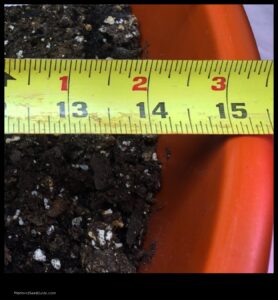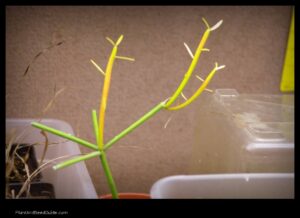
How to Plant Lettuce in a Raised Bed
Lettuce is a cool-weather crop that is easy to grow in a raised bed. Raised beds provide good drainage and aeration, which are essential for growing healthy lettuce plants.
This article will provide you with step-by-step instructions on how to plant lettuce in a raised bed. We will cover everything from choosing the right raised bed to harvesting your lettuce.

Choosing the Right Raised Bed
The first step is to choose the right raised bed for your lettuce plants. Raised beds should be at least 12 inches deep and 4 feet wide. The length of the bed can vary depending on your space constraints.
The best material for a raised bed is wood. Wood is a natural material that will not leach chemicals into the soil. However, you can also use plastic or metal raised beds if you prefer.
Once you have chosen the right raised bed, you need to fill it with soil.
You can either buy a commercial potting mix or make your own soil mix using compost, peat moss, and perlite.The best soil for growing lettuce is a loose, well-draining soil that is rich in organic matter..
Preparing the Raised Bed
Before you plant your lettuce seeds, you need to prepare the raised bed. First, remove any weeds or debris from the bed. Then, loosen the soil with a rake or garden fork.
If your soil is not very fertile, you can add a layer of compost or fertilizer to the bed. This will help to provide your lettuce plants with the nutrients they need to grow.
Once the bed is prepared, you can start planting your lettuce seeds.

Planting Lettuce Seeds
Lettuce seeds are very small, so it is important to plant them at the correct depth. Lettuce seeds should be planted about 1/4 inch deep.
Lettuce seeds can be planted directly in the ground or in seed trays. If you are planting them directly in the ground, space the seeds about 2 inches apart. If you are planting them in seed trays, space the seeds about 1 inch apart.
Once the seeds are planted, cover them with soil and water them gently.
Caring for Your Lettuce Plants
Lettuce plants are relatively easy to care for. They need full sun, regular watering, and well-draining soil.
Lettuce plants should be watered regularly, but not too much. Too much water can cause the roots to rot. Water your lettuce plants deeply once or twice a week, or more often if the weather is hot and dry.
Lettuce plants also need full sun to grow properly. They should be planted in a location where they will receive at least 6 hours of direct sunlight each day.
Lettuce plants are not heavy feeders, but they do benefit from a little fertilizer. You can fertilize your lettuce plants once a month with a balanced fertilizer.
Harvesting Your Lettuce
Lettuce is ready to harvest when the leaves are about 4 inches long. To harvest your lettuce, simply cut the leaves off at the base of the plant.
You can harvest lettuce leaves as you need them, or you can harvest the entire plant at once. If you are harvesting the entire plant, cut it off at the base of the stem.
Lettuce can be stored in the refrigerator for up to a week. To store lettuce, place the leaves in a plastic bag and seal it tightly.
Pests and Diseases
Lettuce plants are susceptible to a variety of pests and diseases. Some of the most common pests that attack lettuce include aphids, slugs, and caterpillars. Some of the most common diseases that affect lettuce include powdery mildew, downy mildew, and leaf spot.
If you notice any pests or diseases on your lettuce plants, you can treat them with a variety of organic pesticides and fungicides. You can also prevent pests and diseases by practicing good gardening habits, such
| Feature | Description |
|---|---|
| Raised bed gardening | A type of gardening that involves growing plants in raised beds. Raised beds are typically elevated above the ground, which helps to improve drainage and aeration. They can also be used to create more space for gardening in small areas. |
| Lettuce | A leafy green vegetable that is a popular choice for home gardeners. Lettuce is relatively easy to grow, and it can be harvested throughout the growing season. |
| Gardening | The practice of growing plants for food, flowers, or other purposes. Gardening can be a fun and rewarding hobby, and it can also be a way to get fresh, healthy food. |
| Vegetable gardening | The practice of growing vegetables for food. Vegetable gardening can be a great way to get fresh, healthy vegetables for your family. |
| Growing lettuce | The process of growing lettuce. Lettuce can be grown from seed or seedlings. It is a relatively easy plant to grow, and it can be harvested throughout the growing season. |
IChoosing the Right Raised Bed
When choosing a raised bed for growing lettuce, there are a few things to consider.
First, you need to decide how much space you have. Lettuce plants need about 12 inches of space each, so you will need to plan accordingly.
Second, you need to decide what type of material you want your raised bed to be made of. There are a variety of materials available, including wood, plastic, and concrete. Each material has its own advantages and disadvantages.
Wooden raised beds are the most traditional option, and they are relatively easy to build. However, they can be more expensive than other materials and they require more maintenance.
Plastic raised beds are a more affordable option, and they are also easier to maintain than wooden beds. However, they can be less durable than wood and they may not look as nice.
Concrete raised beds are the most durable option, but they are also the most expensive and the most difficult to build.
Once you have considered these factors, you can choose the raised bed that is right for you.
Preparing the Raised Bed
The first step in planting lettuce in a raised bed is to prepare the soil. The soil should be loose and well-drained. If the soil is too compacted, it will be difficult for the roots of the lettuce plants to grow. You can improve the drainage of the soil by adding compost or sand.
You should also test the pH of the soil before planting lettuce. Lettuce prefers a slightly acidic soil, with a pH of 6.0 to 6.8. If the pH of the soil is too high or too low, you can adjust it by adding lime or sulfur.
Once the soil has been prepared, you can begin planting the lettuce seeds.
You can either sow the seeds directly in the raised bed, or you can start them indoors and transplant them into the raised bed once they have grown a few leaves.Lettuce seeds are very small, so you should sow them thinly..
When planting the lettuce seeds, make sure to water them well. The seeds need to be kept moist in order to germinate. You can cover the seeds with a thin layer of soil or compost to help keep them moist.
Planting Lettuce Seeds
To plant lettuce seeds, you will need:
- Lettuce seeds
- A raised bed
- Soil mix
- A watering can
To plant the seeds, follow these steps:
- Sow the seeds 1/4 inch deep in the soil mix.
- Cover the seeds with soil mix.
- Water the seeds well.
- Place the raised bed in a sunny location.
The seeds will germinate in about 7-10 days. Once the seedlings have emerged, thin them so that they are 2-3 inches apart.
Water the seedlings regularly, making sure to keep the soil moist but not soggy.
Fertilize the seedlings once a month with a balanced fertilizer.
The lettuce will be ready to harvest in about 45-60 days.
Caring for Your Lettuce Plants
Once your lettuce plants have sprouted, you will need to care for them properly in order to ensure a bountiful harvest. Here are a few tips on how to care for your lettuce plants:
- Water your lettuce plants regularly, especially during hot weather.
- Fertilize your lettuce plants every 2-3 weeks with a balanced fertilizer.
- Thin out your lettuce plants as they grow to ensure that they have enough space to grow.
- Monitor your lettuce plants for pests and diseases and treat them accordingly.
By following these tips, you can help your lettuce plants grow strong and healthy, and you will be rewarded with a delicious harvest of fresh lettuce.
VHarvesting Your Lettuce
Once your lettuce plants have reached maturity, you can start harvesting them. To do this, simply cut the leaves off of the plant at the base. Be sure to leave a few leaves on each plant so that it can continue to grow.
You can harvest lettuce leaves as you need them, or you can harvest the entire plant at once. If you are harvesting the entire plant, be sure to cut it off at the base of the stem.
Lettuce can be stored in the refrigerator for up to a week. To store it, place the leaves in a sealed container or bag.
Storing Your Lettuce
Once your lettuce is harvested, you can store it in the refrigerator for up to two weeks. To do this, place the lettuce leaves in a sealed plastic bag or container. You can also freeze lettuce for longer storage. To freeze lettuce, wash and dry the leaves, then cut them into small pieces. Place the pieces in a freezer bag or container, and freeze for up to six months.
Pests and Diseases
Pests and Diseases
Lettuce is a relatively pest-free crop, but there are a few pests that can occasionally cause problems.
The most common pests of lettuce are aphids, leafhoppers, and slugs.
Aphids are small, sap-sucking insects that can cause leaves to wilt and turn yellow.
Leafhoppers are also small insects that feed on the sap of lettuce leaves.
Slugs are mollusks that feed on the leaves of lettuce plants, often leaving behind a slimy trail.
To control pests, you can use a variety of methods, including:
• Hand-picking pests. This is the most effective way to control pests, but it can be time-consuming.
• Using insecticidal soap. Insecticidal soap is a safe and effective way to control aphids and leafhoppers.
• Using a biological control. Biological controls are predators or parasites that feed on pests.
• Using a repellent. Repellents can help to keep pests away from your lettuce plants.
If you have a severe pest infestation, you may need to use a chemical pesticide.
Be sure to read the label carefully and follow the directions on the label before using any pesticide.
Troubleshooting
Here are some common problems that you may encounter when growing lettuce in a raised bed, and how to troubleshoot them:
- Lettuce seedlings not germinating: If your lettuce seedlings are not germinating, it is likely due to one of the following reasons:
- The soil is too cold. Lettuce seeds need warm soil to germinate, so if the soil temperature is below 70 degrees Fahrenheit, your seeds will not germinate.
- The soil is too wet. Lettuce seeds need moist soil to germinate, but if the soil is too wet, it will drown the seeds and prevent them from germinating.
- The seeds are old. Lettuce seeds have a shelf life of about one year, so if your seeds are older than that, they may not germinate.
To troubleshoot this problem, try the following:
- Check the soil temperature. If the soil temperature is below 70 degrees Fahrenheit, wait until the temperature rises before planting your seeds.
- Make sure the soil is moist, but not wet.
- Use fresh seeds.
- Lettuce seedlings wilting: If your lettuce seedlings are wilting, it is likely due to one of the following reasons:
- The plants are not getting enough water. Lettuce needs regular watering, so if the plants are not getting enough water, they will wilt.
- The plants are getting too much sun. Lettuce does not like to be in direct sunlight all day, so if the plants are getting too much sun, they will wilt.
- The plants are in too much heat. Lettuce does not like hot weather, so if the plants are in too much heat, they will wilt.
To troubleshoot this problem, try the following:
- Water the plants regularly.
- Provide shade for the plants if they are getting too much sun.
- Move the plants to a cooler location if they are in too much heat.
- Lettuce leaves turning yellow: If your lettuce leaves are turning yellow, it is likely due to one of the following reasons:
- The plants are not getting enough nutrients. Lettuce needs a variety of nutrients to grow healthy, so if the plants are not getting enough nutrients, their leaves will turn yellow.
- The plants are getting too much water. Lettuce does not like to be in soggy soil, so if the plants are getting too much water, their leaves will turn yellow.
- The plants are getting too much sun. Lettuce does not like to be in direct sunlight all day, so if the plants are getting too much sun, their leaves will turn yellow.
To troubleshoot this problem, try the following:
- Fertilize the plants regularly.
- Water the plants only when the soil is dry to the touch.
- Provide shade for the plants if they are getting too much sun.
- Lettuce leaves being eaten by pests: If your lettuce leaves are being eaten by pests, it is likely due to one of the following reasons:
- The plants are being attacked by aphids. Aphids are small, green insects that suck the sap out of plants, causing the leaves to wilt and turn yellow.
- The plants are being attacked by slugs. Slugs are slimy, gray-brown creatures that eat holes in leaves.
- The plants are being attacked by caterpillars. Caterpillars are small, green worms that eat leaves.
To troubleshoot this problem, try the following:
- Inspect the plants regularly for signs of pests.
- If you see pests, hand-pick them off the plants and destroy them.
- Use a natural insecticide, such as neem oil or insecticidal soap, to kill pests.
FAQ
Q: What is the best way to prepare the soil for planting lettuce in a raised bed?
A: The best way to prepare the soil for planting lettuce in a raised bed is to mix in a generous amount of compost or well-rotted manure.
This will help to improve the drainage and fertility of the soil, and it will also provide the lettuce plants with the nutrients they need to grow..
Q: What is the best time to plant lettuce in a raised bed?
A: The best time to plant lettuce in a raised bed is in the early spring, after the last frost. Lettuce is a cool-weather crop, so it does not tolerate heat well. If you live in a warm climate, you may need to start your lettuce seeds indoors and transplant them into the raised bed after the weather has cooled down.
Q: What is the best variety of lettuce to plant in a raised bed?
A: There are many different varieties of lettuce to choose from, so the best variety for you will depend on your climate and growing conditions. Some popular varieties of lettuce for raised beds include:
Romaine lettuce
Iceberg lettuce
Butterhead lettuce
Leaf lettuce
Red leaf lettuce
- Wild Rose Country: Exploring Untamed Beauty - July 15, 2024
- Wildflower Nursery Decor: Bringing Nature Indoors - July 15, 2024
- Young Sprout of Grass: Nurturing New Life - July 15, 2024








